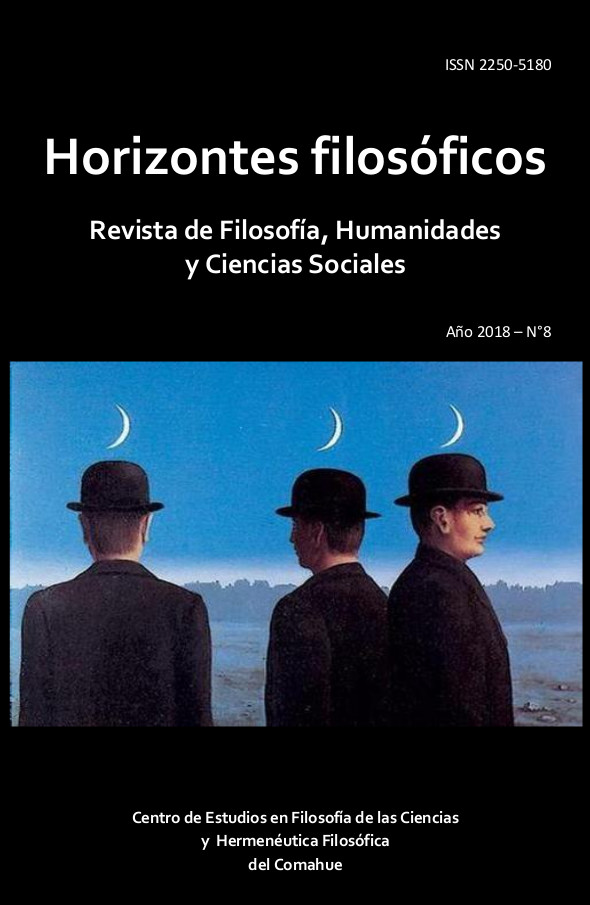El rol de Climacus en la estrategia comunicativa de Kierkegaard
Keywords:
Pseudónimos, Climacus, Comunicación, ComicidadAbstract
La función de los autores pseudónimos en la obra de Kierkegaard ha generado un intenso debate entre los especialistas. Muchos de ellos se preocuparon por determinar cuál pseudónimo representa el pensamiento del autor danés. El objetivo de este artículo es discutir la búsqueda de identidad entre Kierkegaard y los pseudónimos a partir del análisis de la comunicación indirecta y del rol particular que desempeñaClimacus en 1846, cuando el danés consideraba abandonar la escritura. En este contexto, concebimos a Climacus como un alter ego circunstancial cuyo objetivo consiste en ofrecer un criterio ordenador de las esferas de la existencia, previamente utilizadas de modo no articulado, a través de la introducción del concepto de “comicidad”.
Downloads
References
BARRETT, L. (1997) “Subjectivity is (un)truth: Climacus’s dialectically
sharpened pathos”, in International Kierkegaard Commentary,
Concluding Unscientific Postscript to “Philosophical Fragments”,
volume 12, edited by Robert L. Perkins, Georgia, Mercer
University Press, pp.291-306.
----------------(2015) “Johannes Climacus: Humorist, Dialectician and
Gadfly”, en: Kierkegaard’s Pseudonyms, Volume 17, Ashgate
Publishing Ltd, Gower House, Croft Road, Aldershot, Hants, GU11
HR, U.K., pp. 117-142.
BASSO, I. (2005) “The Italian Reception of Kierkegaard’s Concluding
Unscientific Postscript”, in Kierkegaard’s Studies. Yearbook 2005,
edited on behalf of the Søren Kierkegaard Research Centre by
Niels Jørgen Cappelørn and Hermann Densen, Berlin, Walter de
Gruyter, pp.400-417.
DUNNING, S. (1981) “”The dialectic of contradiction in Kierkegaard’s
aesthetic stage”, en The Journal of the American Academy of
Religion, XLIX/3, pp.383-408.
GUEVARA, A. (2003) “La creencia en Kierkegaard, Johannes de Silentio y
Anti-Climacus”, en Teorema, Vol.XXII/3, pp.101-114.
KIERKEGAARD, S. (1997-2009) Søren Kierkegaards Skrifter (SKS), (ed.)
N. J Cappelørn, J. Garff , J. Kondrup, A. McKinnon y F. H.
Mortensen, Copenhague, Søren Kierkegaard Forskningscenteret
y Gads Forlag.
-------------------- (2010) Postscriptum no científico y definitivo a Migajas
Filosóficas, traducción Javier Teira y Nekane Legarreta,
Salamanca, Sígueme.
------------------- (2009) Postscriptum no científico y definitivo a Migajas
Filosóficas, traducción y estudio introductorio de Nassim Bravo
Jordán: México D.F., Universidad Iberoamericana.
-------------------(1980) Diario 3, a cura di Cornelio Fabro, Brescia,
Morcelliana.
LIPPITT, J. (2000) Humor and irony in Kierkegaard’s thought. New York,
St. Martin’s Press.
LOWRIE, W. (1968) “Editor’s Introduction”, en: Kierkegaard, S.,
Concluding Unscientific Postscript, ed. and trans. by David
Swenson and Walter Lowrie, Princeton, Princeton University
Press.
MAREK, J. (2015) “Anti-Climacus: Kierkegaard’s “Servant of the Word””,
en: Kierkegaard’s Pseudonyms, Volume 17, Ashgate Publishing Ltd,
Gower House, Croft Road, Aldershot, Hants, GU11 3HR, U.K., pp.
-50.
PERKINS, R. (1997) “Climacan Politics: Person and Polis in Kierkegaard’s
Postscript”, in International Kierkegaard Commentary,
Concluding Unscientific Postscript to “Philosophical Fragments”,
volume 12, edited by Robert L. Perkins, Georgia, Mercer
University Press, pp. 33-52.
WESTFALL, J. (2015) “A, B, and F...:Kierkegaard ́s use of Anonymus”, en:
Kierkegaard’s Pseudonyms, Volume 17, Ashgate Publishing Ltd,
Gower House, Croft Road, Aldershot, Hants, GU11 3HR, U.K., pp.
-38.
Downloads
Published
How to Cite
Issue
Section
License
Atribución-NoComercial-SinDerivadas 2.5 Argentina (CC BY-NC-ND 2.5 AR)
Usted es libre de:
Compartir — copiar y redistribuir el material en cualquier medio o formato
La licenciante no puede revocar estas libertades en tanto usted siga los términos de la licencia





